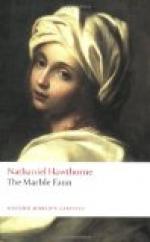So Hilda became a copyist: in the Pinacotheca of the Vatican, in the galleries of the Pam-fili-Doria palace, the Borghese, the Corsini, the Sciarra, her easel was set up before many a famous picture by Guido, Domenichino, Raphael, and the devout painters of earlier schools than these. Other artists and visitors from foreign lands beheld the slender, girlish figure in front of some world-known work, absorbed, unconscious of everything around her, seeming to live only in what she sought to do. They smiled, no doubt, at the audacity which led her to dream of copying those mighty achievements. But, if they paused to look over her shoulder, and had sensibility enough to understand what was before their eyes, they soon felt inclined to believe that the spirits of the old masters were hovering over Hilda, and guiding her delicate white hand. In truth, from whatever realm of bliss and many colored beauty those spirits might descend, it would have been no unworthy errand to help so gentle and pure a worshipper of their genius in giving the last divine touch to her repetitions of their works.
Her copies were indeed marvellous. Accuracy was not the phrase for them; a Chinese copy is accurate. Hilda’s had that evanescent and ethereal life—that flitting fragrance, as it were, of the originals—which it is as difficult to catch and retain as it would be for a sculptor to get the very movement and varying color of a living man into his marble bust. Only by watching the efforts of the most skilful copyists—men who spend a lifetime, as some of them do, in multiplying copies of a single picture—and observing how invariably they leave out just the indefinable charm that involves the last, inestimable value, can we understand the difficulties of the task which they undertake.
It was not Hilda’s general practice to attempt reproducing the whole of a great picture, but to select some high, noble, and delicate portion of it, in which the spirit and essence of the picture culminated: the Virgin’s celestial sorrow, for example, or a hovering angel, imbued with immortal light, or a saint with the glow of heaven in his dying face,—and these would be rendered with her whole soul. If a picture had darkened into an indistinct shadow through time and neglect, or had been injured by cleaning, or retouched by some profane hand, she seemed to possess the faculty of seeing it in its pristine glory. The copy would come from her hands with what the beholder felt must be the light which the old master had left upon the original in bestowing his final and most ethereal touch. In some instances even (at least, so those believed who best appreciated Hilda’s power and sensibility) she had been enabled to execute what the great master had conceived in his imagination, but had not so perfectly succeeded in putting upon canvas; a result surely not impossible when such depth of sympathy as she possessed was assisted by the delicate skill and accuracy of her slender hand. In such cases the girl was but a finer instrument, a more exquisitely effective piece of mechanism, by the help of which the spirit of some great departed painter now first achieved his ideal, centuries after his own earthly hand, that other tool, had turned to dust.




